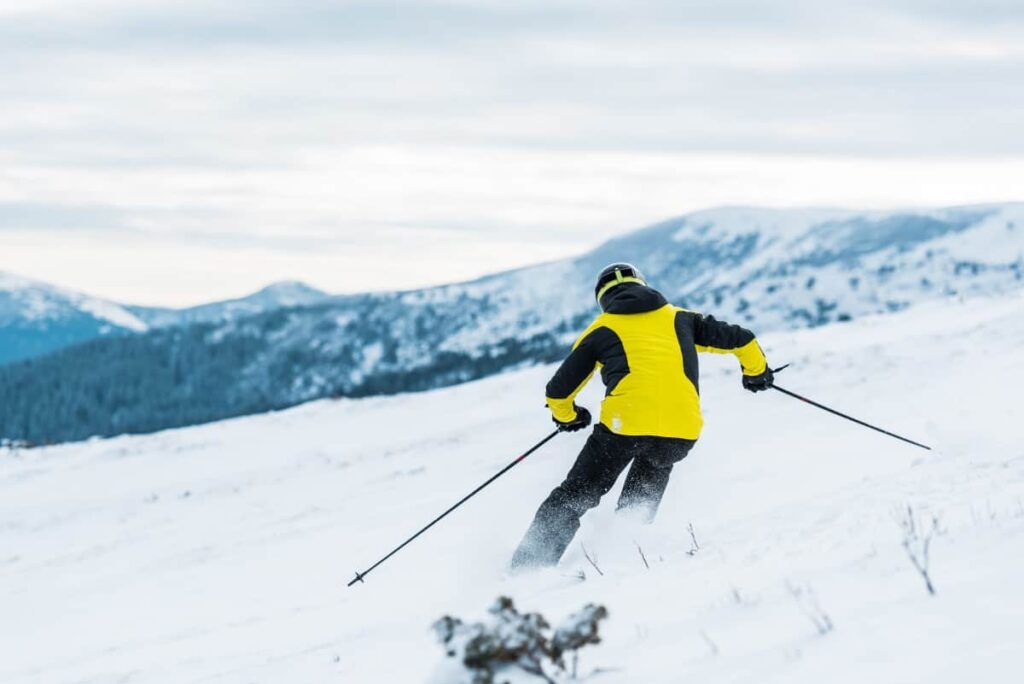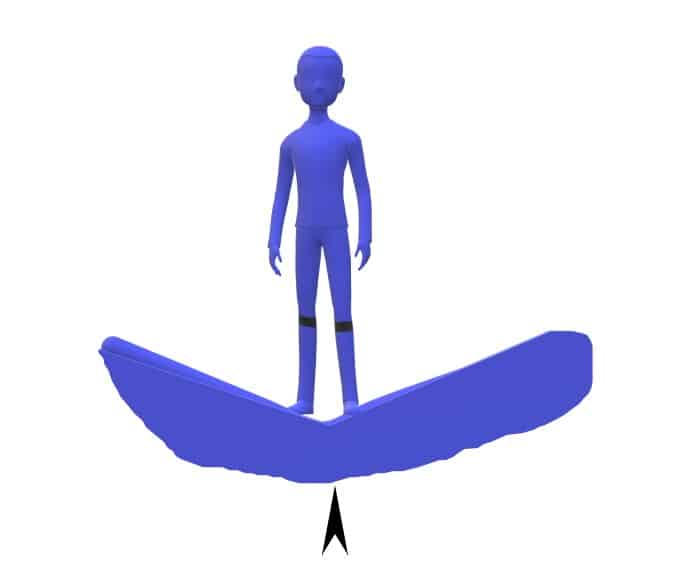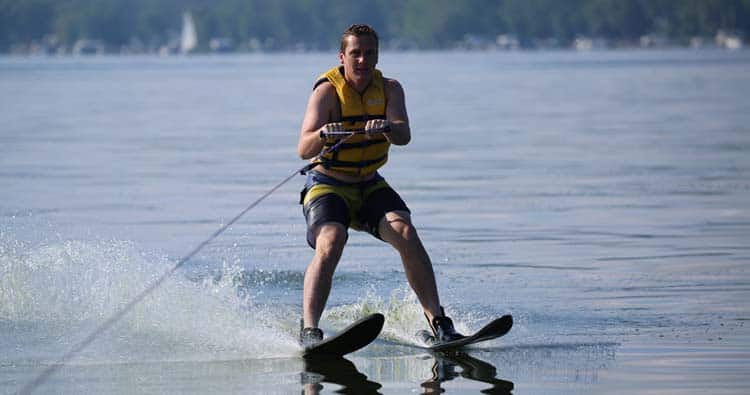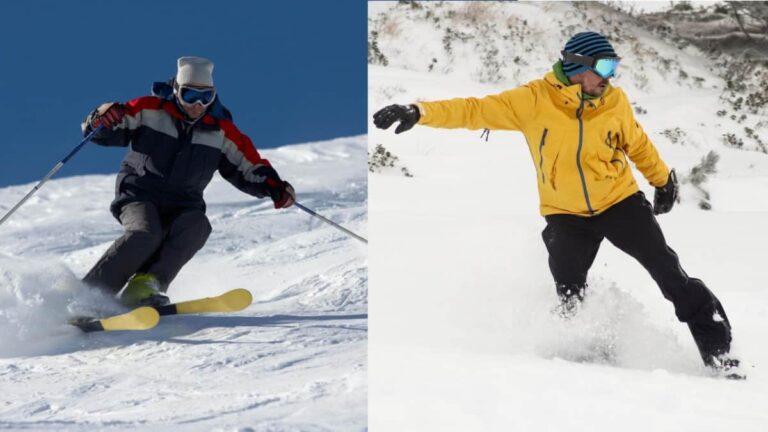Why Do Skis Have To Be So Long?
Most skiers have been in the position of being in a tight space and watching someone awkwardly try to grab their skis and rush out without knocking anybody out along the way. When skis are off, they can be a hazard. When they’re on (a beginner), they can get crossed over and just look awkward. Why do skis need to be so long?!
Longer skis have a greater surface area, are heavier, and have more contact with the ground. These attributes help skis to be more stable and keep the skier steady at faster speeds. Faster speeds can be reached the longer, and broader the ski is, as weight is dispersed more evenly along the ski.
While the speed you go at and the type of terrain you’re skiing on differ from person to person, there are ways to use the ski length to your advantage to ski better in different situations. Once you understand why ski length is important that helps even more! Let’s have a look at the importance of ski length so you can make informed decisions next time you’re picking your perfect pair.

Why Are Skis So Long?
There’s some science involved here, but the short answer is because you need the length in order to remain stable and not fall headfirst down a snowy mountain! Let’s have a deeper look at what actually goes on, though.
Less Pressure = Better Gliding For Your Skis
Gravity constantly pulls us downwards towards the earth. The point you’re on becomes more compressed when weight is more concentrated, for example, when we stand up rather than lie down. Imagine it in terms of standing on a mattress.

The mattress sinks deeper under our feet when we’re standing than when we are lying on it. It is the same with snow. There is more pressure when our weight is concentrated under our feet rather than distributed if we were lying down.

So standing on snow means that our weight, and consequently the pressure under our feet, is very concentrated. Skis help to distribute that weight by making the surface area onto which that pressure is going larger. There is less pressure per square inch. The strength of push per square inch is called call pressure, and skis reduce that. The longer the skis, the less pressure per square inch on the snow.
So, if you think about it, if you are standing in the snow without skis on, you just sink into the snow. It’s because skis distribute your weight over a larger area that you are able to glide on the snow rather than sink.
Longer Skis Help You Balance
Gravity pulls on the point at which our weight puts pressure on the ground (called center mass), and if that point is located above the contact we have with the ground, then we don’t end up falling over. The larger the contact area, the easier it is to keep our balance and the less likely we are to fall.
With longer skis, we feel more stable. Given that you travel downhill when skiing, we lean forward, and our weight is distributed forward. If our skis are underneath this forward-leaning weight, then it helps to create a balanced contact area for gravity, and we feel more stable.

So, while skis may be incredibly awkward off the mountain, their length makes your life much easier and more stable on the mountain. When you think about the fact that strapping poles to your shoes to slide down a mountain, the smoother and more stable that journey is, the better!
In short, the ski’s length also helps you balance as you are skiing downward.
This is part of why cross-country skis are shorter than downhill skis–you are not going downhill all the time, but in fact, you are going downhill and uphill, and thus cross-country skis are made shorter.
How Long Do Skis Need to Be?
Because the length of your skis affects your balance, it is completely dependent on your height. If you’re following a general rule, skis need to reach somewhere between your chin and the top of your head when resting with the back of the skis on the ground. Expert skiers may choose to have skis that are slightly taller than their heads, but there is no strict rule about the length that your skis need to be. (source)
The terrain you ski on, your height and weight, and your personal style (including your turns, speed, etc.) all depend on the length that your skis should be. If you have never skied before and don’t know where to start, the general rule above is a good guideline to follow, and sticking to the shorter side – top of the chest to chin height. This makes turning easier and gathering speed less intimidating.
Note, too short of skis can make it more difficult to balance as well–so, like anything, it’s important to find the right balance between speed and control and … well… balance.
Is It Better To Have Longer Skis Or Shorter Skis?
This is a personal preference, and there is no ‘better to have.
Reasons Why You Might Want Longer Skis
(skis longer than the top of your head):
- You want to ski faster
- You ski mostly on powder or off-piste
- You are a more aggressive skier
- You make longer turns
- You weigh more than average for your height
- You are taller than average
- You’re a more advanced skier
The longer your skis are, the more distributed your weight is, which allows you to go faster, as there is less pressure exerted on the snow. Essentially, this distributed weight makes you ‘lighter’ on the snow because the call pressure is reduced. A greater surface area, therefore, helps you to stay ‘floating’ in powder, for example.
Longer skis do have a larger turning radius and require more effort/strength to turn the ski, which is why they are better suited to more advanced skiers. They also increase stability in more variable snow conditions.
On the other hand, you might tend towards choosing a shorter ski if the following apply to you.
Reasons Why You Might Want Shorter Skis:
- You are a beginner or intermediate skier
- You want carving skis
- You tend to make shorter turns (also better if you are more advanced but ski slalom)
- You weigh less than the average for your height
- You are shorter than average
Shorter skis are better in terrain with lots of bumps and trees because the turning circle is smaller. Conversely, they don’t float well in powder or handle unsteady snow as well because they are less balanced.
In general, longer skis are more stable but harder to control. With different advantages offered by the ski lengths, it is a personal choice of what length to get, depending on how you ski, your preferred terrain, and your weight/height profile.
How Heavy Should Your Skis Be?
(As a note, downhill skis with bindings on them weigh between 8 to 14 lbs (4-6 kg).)
- Lighter skis are better for powder and less tiring to ski on.
- Racing skis need to be heavier because they need rigidity and power in order to turn and generate speed quickly on the exit of turns.
- For those doing backcountry-skiing, having lighter skis will make carrying them a whole lot easier and the whole experience that much more amazing.
So, in short, the weight you need for your skis depends on what you’re trying to do.
Just as your weight affects the skis, the weight of the skis affects your skiing. Depending on what type of skiing you’re doing, your skis should have different characteristics, weight being one of them. The weight will depend both on the purpose they were designed for, the type of skiing, and on the material from which they are made. For this reason, longer skis do not necessarily mean that they’re heavier than shorter skis.
There is no requirement on how much skis need to weigh, and unless you’re a professional, or at least very serious about your skiing, there is not too much need to worry about the weight of your skis. It is far better to focus on other characteristics, such as length and shape, that will have an impact on the way that you ski.
Conclusion
Gravity acts in such a way that having a large contact area with the ground helps us to feel more stable. When sliding down a mountain at speed over variable terrain, we need all the stability we can get in order to stay safe. The length of skis helps us to increase our surface area and our balance, but skis come in all different lengths, widths, shapes, and types. How you combine these design aspects into one ski is ultimately your own personal choice.

